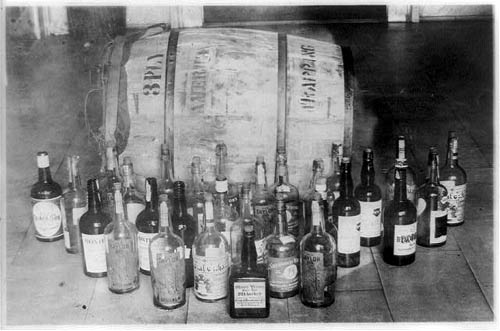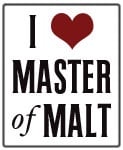 Right, like I was saying, Phylloxera came to the vines of Europe bringing the production of wine spirits to a halt. So the 1880s became a great boom period in the history of whisky and the demand for the product soared as brandy and cognac cellars of the middle classes dried up. Irish whisky saw a great increase in sales during this time and in Scotland, blenders worked frantically to meet demand. Twenty-seven(27) distilleries that still operate today(49 in total) were built between 1879 and 1899, including North British Grain distillery, Aberlour (sold to blenders by 1892), Bunnahabhain, Craigallachie (built by White Horse's Peter Mackie and whisky blender Alexader Edward), Glenfiddich in 1887 and Balvenie 5 years later by William Grant, and Ardmore by William Teacher & Sons.
Right, like I was saying, Phylloxera came to the vines of Europe bringing the production of wine spirits to a halt. So the 1880s became a great boom period in the history of whisky and the demand for the product soared as brandy and cognac cellars of the middle classes dried up. Irish whisky saw a great increase in sales during this time and in Scotland, blenders worked frantically to meet demand. Twenty-seven(27) distilleries that still operate today(49 in total) were built between 1879 and 1899, including North British Grain distillery, Aberlour (sold to blenders by 1892), Bunnahabhain, Craigallachie (built by White Horse's Peter Mackie and whisky blender Alexader Edward), Glenfiddich in 1887 and Balvenie 5 years later by William Grant, and Ardmore by William Teacher & Sons. The boom was followed by a bust. In 1898 Pattison's, a major blending and bonding broker, went bankrupt. The brothers Pattison, Robert and Walter, had taken advantage of investors and had built an empire of the power of credit and when they went bankrupt after a bank refused to float them, they brought down a large chunk of the whisky industry in Scotland (more here). Many distilleries were closed and the high production of the past decade left millions of casks laid down with no buyers.
The boom was followed by a bust. In 1898 Pattison's, a major blending and bonding broker, went bankrupt. The brothers Pattison, Robert and Walter, had taken advantage of investors and had built an empire of the power of credit and when they went bankrupt after a bank refused to float them, they brought down a large chunk of the whisky industry in Scotland (more here). Many distilleries were closed and the high production of the past decade left millions of casks laid down with no buyers.In spite of this crushing collapse, the following years provided a few small victories for Scotch whisky. Malt whisky distillers needed to protect their trades and insisted that blends should have minimum single malt whisky content. In 1909 a Royal Commission decided that "Scotch Whisky embraced malt, grain, and blended whisky, no matter how little malt was incorporated in the blend." This may sound like a negative, but it ensured that whisky stayed alive through the tough times of taxation and war that lay ahead.
During the First World War, Chancellor of the Exchequer, Lloyd George made several efforts to move towards prohibition of alcohol. In 1915 he said, "We are fighting Germany, Austria--and Drink. And as far as I can see the greatest of these deadly foes is Drink!" He introduced the Immature Spirit Act of 1915 that would ensure that spirit had to be matured at least two years before it could be sold. This hurt Irish whisky the most as Malt whisky distilleries in Scotland already had a tradition of maturing in oak barrels. The Irish War of Independence in 1916 didnt help things either. Duty was introduced on spirits and this greatly damaged Irish whisky sales in 'English' markets (Australia, New Zealand, India, Caribbean). Add to this the loss of Irish whisky's American market to Prohibition and a recovery for Irish whisky was nearly impossible. The combination of the struggles of Irish whisky and the 'no-minimum malt' in blended whisky policy helped Scottish whisky survive even when single malt distilleires had to close during wartime.
 And prohibition in America actually HELPED the whisky industry in Scotland (and Canada, for that matter. Partial prohibition in Canada in 1918 hurt whisky makers in Canada, but the opportunity that national Prohibition caused in America healed those wounds quickly.) When the Volstead Act or the National Prohibition Act was passed in 1919, the demand for liqour fuelled many criminal activities and funded many criminals (Al Capone, Bugs Moran, etc.) and Scotch whisky sales soared.
And prohibition in America actually HELPED the whisky industry in Scotland (and Canada, for that matter. Partial prohibition in Canada in 1918 hurt whisky makers in Canada, but the opportunity that national Prohibition caused in America healed those wounds quickly.) When the Volstead Act or the National Prohibition Act was passed in 1919, the demand for liqour fuelled many criminal activities and funded many criminals (Al Capone, Bugs Moran, etc.) and Scotch whisky sales soared.Famously, Laphroaig made it past customs because of its simple labelling and medicinal smell convincing officers that it was in fact medicine, a "cholera mixture". Doc Wellbanks was a vetrinarian and as such, legally allowed to buy whisky to use as medicine for (happy) horses. Naturally, he became a legend, and it wasnt just horses singing his praises. Whisky like Chivas, Dewars, and Cutty Sark entered the United States through agents who set up businesses in Canada, Nassau, or the Bahamas. Many people exploited this and bootlegged some very cheap, immature spirit. Captain William McCoy who shipped Berry Brothers & Rudd's products(Cutty Sark), earned a reputation as a supplier of real Scottish, quality whisky, entering our language to affirm authenicity, as "the real McCoy". In Canada, Hiram Walker and the Sam Bromfmans(Seagrams, pictured) made fortunes as illegal shippers of whisky across the border from Windsor to Detroit.

Advertising was used to great effect by whisky blenders. The Pattisons were real innovators in this regard, and the tradition of clever marketing continued beyond their collapse. Each blend worked to find its own niche market. Teacher's had their dram shops to get customers to drink their blends and their "Experience is the great Teacher, Teacher's is the great experience" series of adverts. Vat 69 got its military association in 1905 when a writer in the War Office Times and Naval Review wrote, "Directly we sampled this whisky we said to ourselves:'This is the ideal whisky so many of our Service readers have been looking for, and hitherto in vain'[...] We have confidence in recommending it to our readers." The cultural impact of Scottish whisky was felt throughout the world, with whisky becoming a status symbol, combining images of a rugged heritage with sophisticated taste, success, and wealth. Johnnie Walker saw itself as "the first truly global brand," being sold in over 120 countries. Sport affiliation and the promotion of Scottish heritage through advertising for Scotch whisky helped whisky stay popular around the world even as Japanese and American distilling grew.
The 1950s through the 1970s represented a 'golden age' for the Scotch whisky industry. Consumption in traditional markets rose steadily, and new markets emerged in Japan and the European Community and Japan. Worldwide sales grew at a compound rate of 9% per annum. The world recession in 1975 kept the escalating production of scotch whisky in check, but a surplus problem loomed. What followed was a trend towards healthier living, drunk driving laws, a turn away from brown spirits, and thus a decline in whisky consumption. By 1986 around a quarter of all distilleries were closed, demolished or motbballed/ceased production.
 Today, the whisky climate is hot, perhaps even too hot. Next weekend I will try to look at trends in marketing and production, the current state and future of the industry, and what it all means to the whisky drinker of today.
Today, the whisky climate is hot, perhaps even too hot. Next weekend I will try to look at trends in marketing and production, the current state and future of the industry, and what it all means to the whisky drinker of today.[Sources: many human beings (within and without the whisky industry), a few websites(many great whisky nerds have graced this e-world with their knowlege before me. Slainte and thanks), and serveral books: Jim Murray's 'Classic Blended Scotch', Dave Broom's 'Handbook of Whisky', Helen Arthur's 'Whisky', John Hughes' 'Scotland's Malt Whisky Distilleries', ALL of Charlie Maclean's work, and the Malt Whisky Yearbook 2006 and 2007]
Bullocks to Blends? (Part One)
Malt Mission HOME





1 comment:
I am enjoying your commentaries.
I would like to find out more about Pattisons. Do you have any more information that you may be willing to share/pass on to me?
Yours
Sadie
Post a Comment